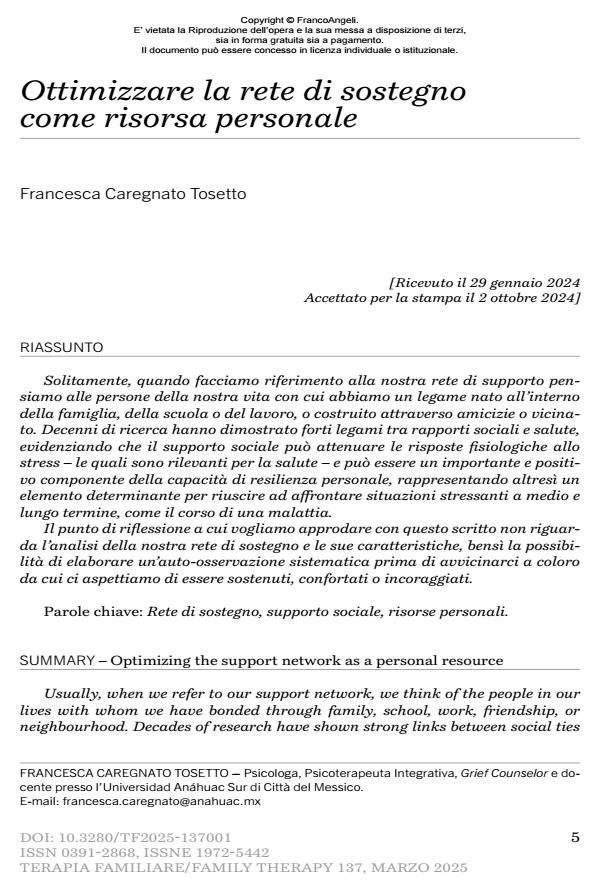Ottimizzare la rete di sostegno come risorsa personale
Titolo Rivista TERAPIA FAMILIARE
Autori/Curatori Francesca Caregnato Tosetto
Anno di pubblicazione 2025 Fascicolo 2025/137
Lingua Italiano Numero pagine 16 P. 5-20 Dimensione file 173 KB
DOI 10.3280/TF2025-137001
Il DOI è il codice a barre della proprietà intellettuale: per saperne di più
clicca qui
Qui sotto puoi vedere in anteprima la prima pagina di questo articolo.
Se questo articolo ti interessa, lo puoi acquistare (e scaricare in formato pdf) seguendo le facili indicazioni per acquistare il download credit. Acquista Download Credits per scaricare questo Articolo in formato PDF

FrancoAngeli è membro della Publishers International Linking Association, Inc (PILA)associazione indipendente e non profit per facilitare (attraverso i servizi tecnologici implementati da CrossRef.org) l’accesso degli studiosi ai contenuti digitali nelle pubblicazioni professionali e scientifiche
Solitamente, quando facciamo riferimento alla nostra rete di supporto pensiamo alle persone della nostra vita con cui abbiamo un legame nato all’interno della famiglia, della scuola o del lavoro, o costruito attraverso amicizie o vicinato. Decenni di ricerca hanno dimostrato forti legami tra rapporti sociali e salute, evidenziando che il supporto sociale può attenuare le risposte fisiologiche allo stress – le quali sono rilevanti per la salute – e può essere un importante e positivo componente della capacità di resilienza personale, rappresentando altresì un elemento determinante per riuscire ad affrontare situazioni stressanti a medio e lungo termine, come il corso di una malattia. Il punto di riflessione a cui vogliamo approdare con questo scritto non riguarda l’analisi della nostra rete di sostegno e le sue caratteristiche, bensì la possibilità di elaborare un’auto-osservazione sistematica prima di avvicinarci a coloro da cui ci aspettiamo di essere sostenuti, confortati o incoraggiati.
Parole chiave:Rete di sostegno, supporto sociale, risorse personali
Francesca Caregnato Tosetto, Ottimizzare la rete di sostegno come risorsa personale in "TERAPIA FAMILIARE" 137/2025, pp 5-20, DOI: 10.3280/TF2025-137001